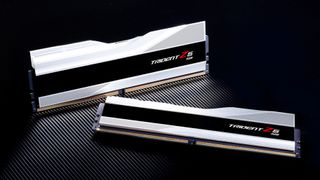DDR4 and DDR5 Memory Price Increases Expected in Q4 2023
It's a subtle increase, but an increase nonetheless

Trendforce reports that DDR4 and DDR5 prices are expected to rise subtly for the remainder of this year. The consumer DRAM market is expected to see price increases by as much as 8% this quarter. Additionally, graphics DRAM is forecast to increase by up to 8% this quarter, which could slightly inflate future graphics card and gaming notebook prices.
The main driving factor behind these new predicted DDR5 and DDR4 price increases is Samsung's recent initiative to reduce surplus inventory. Samsung is doing this by significantly cutting back DRAM production. As a result, manufacturers are looking to increase consumer DRAM contract prices to prevent incurring losses from occurring.
Thankfully, pricing is not increasing as much as DRAM manufacturers hoped, with only a modest 3-8% price hike predicted. This is a result of continued lackluster demand, which was not expected to be the case. But prices are still going up nonetheless.
The consumer DRAM isn't the only market affected by the projected increased DRAM prices. The OEM DRAM market is also facing a similar trend, with a projected 3-8% price hike for DDR5 memory and up to 5% price hike for DDR4. The driving factors behind its DDR5 price increases include new CPU models arriving this year — i.e., Raptor Lake Refresh and Ryzen Threadripper 7000- along with negative gross margins affecting DRAM products, incentivizing DRAM manufacturers to increase prices. The same issues also affect DDR4 prices, which is why DDR4 prices are rising in conjunction with DDR5. Trendforce also reports that DRAM contract prices are predicted to increase by 3-8% as DDR5 adoption accelerates.
Sadly, graphics DRAM (i.e., GDDR6, GDDR6X) is also expected to rise for multiple reasons. Trendforce reports that a niche market dynamic has occurred due to the acceptance of price hikes among graphics card buyers. This has led to the predicted sustained procurement of GDDR6 16Gb chips, which should drive price increases in 2024 for this specific memory model. This is because of inventory stress from DRAM manufacturers, which are experiencing less inventory stress (normal inventory levels) compared to commodity DRAM.
Nvidia's new L40 server GPUs along with hot gaming laptop sales are reportedly facilitating the depletion of manufacturer inventories. These market trends combined have led to the anticipation of a 3-8% price hike in graphics DRAM contract prices for this quarter.
In contrast, the server DRAM market shows no signs of increasing prices for server-based DDR4 and DDR5 memory. The biggest problem with DDR5, specifically, has been its slower-than-expected adoption rate in the server market. Only 15% of the total DDR5 server inventory was reportedly being utilized in servers in Q3, which is very low. On the other hand, with DDR4, Samsung's intensified production cutbacks have caused a supply crunch in server DDR4 stocks, making it impossible to increase DDR4 prices.
Stay On the Cutting Edge: Get the Tom's Hardware Newsletter
Get Tom's Hardware's best news and in-depth reviews, straight to your inbox.
Overall, the general consumer memory market will see a minor increase in memory prices. In turn, this should increase the cost of standalone DDR4/DDR5 memory, OEM/pre-built machines, as well as gaming laptops and standalone graphics cards in the future.

Aaron Klotz is a freelance writer for Tom’s Hardware US, covering news topics related to computer hardware such as CPUs, and graphics cards.
-
t3t4 I heard rumblings about this a little while back, and shortly after the 96 gig pair of stix I was watching dropped a whole $10 in price. I figured I better grab them while I can, cause $379 is better than $389..... The only good thing about this news is knowing a year from now, some of my gear will still be worth almost what I paid for it.Reply
Most Popular



